This website is supported by its readers. If you click one of my links I may earn a commission. I am also a participant in the Amazon affiliates program and I will also earn a commission from qualified purchases.
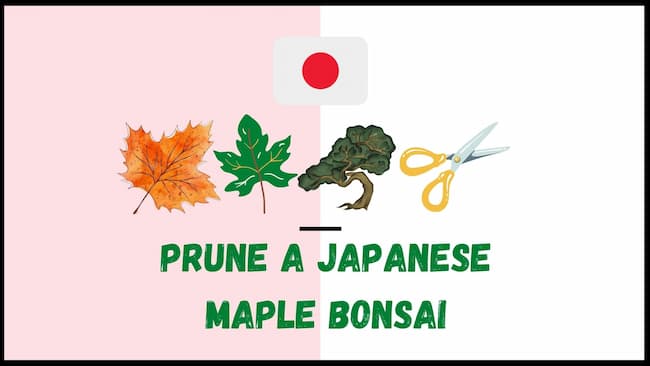
Pruning can be a fun gardening activity, but it’s not something to rush at all, especially with delicate bonsai trees. Before you jump ahead and prune a Japanese maple bonsai tree, you might consider how you can make the most out of the process.
To prune a Japanese maple bonsai, prune the tree in the early spring. Use a sharp pair of shears and prune back new leaf growth until only the first pair of leaves are exposed. This pruning will help create shooter nodes and a denser canopy with better ramification.
In younger bonsai trees that are 1 to 3 years old, prune back the tree in the middle of spring, so the leaves and branches have time to harden up.
Pruning a Japanese maple can be vital for the tree’s growth, structural integrity, and aesthetics. The key is focusing on thinning instead of heading cuts while maintaining the bonsai’s bifurcation.
So, how do you prune a Japanese maple bonsai, what are the common problems to expect, and why should you even do it? That’s what we set out to find!
Just a quick heads up, over the past three years of running Plantpaladin, hundreds of people have asked for product recommendations. As such, You can find my favorite indoor bonsai tree here (link takes you to Bonsaiboy), my favorite outdoor bonsai tree (link takes you to Bonsaiboy), or have a look at all the products I recommend here.
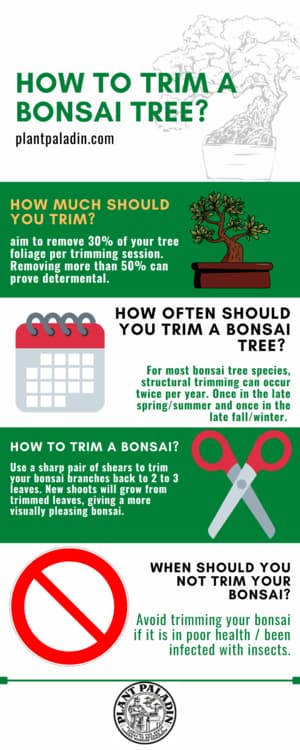
How to Prune a Japanese Maple Bonsai Tree Like a Pro
Only extremely large trees might require the intervention of an arborist for maintenance or structural pruning.
That’s usually not the case with Japanese maple bonsai trees. So, you can tackle it yourself as long as you have the right tools, tips, and tricks up your sleeve.
Tools You’ll Need to Prune a Japanese Maple Bonsai Tree
Some people prune by hand, which works fine for many other plants. However, for the delicate bonsai, you want your cuts to be as precise as possible.
That’s why we’d recommend having these essential items in your pruning toolkit:
- Sharp garden shears (preferably something not too bulky)
- Rubbing alcohol in a spray bottle
- Small cleaning cloth (any clean kitchen rag will do)
- Pair of gloves (optional)
Once these tools are ready, you can jump right into the pruning steps.
Wipe Your Pruning Tools Clean
Start by wiping your garden shears with rubbing alcohol on a clean cloth. Remember that you might need to repeat this step a few times along the way, especially if you have a lot of dead twigs on your bonsai.
It sounds like too much of a hassle, but it beats exposing the fresh plant tissue to microbial infections from a dirt shear.
Some people wear gloves to protect their hands from repeated alcohol wiping. Meanwhile, others prefer ditching the gloves to get a better feel of the delicate twigs. Of course, none of them is wrong, so take your pick between either technique.
Examine the Bonsai Thoroughly for Dead Parts
While you’re at it, look around for any leaves that look crispy and dry. Those will usually look much drier and faded than the vibrant-green branches. The most prominent parts to start with are dead twigs since there usually isn’t much hope of reviving them.
If the dead twigs are all over the bonsai, you might want to conduct a scratch test. If it’s still green under, the plant is still viable, and you go ahead with the pruning, but it’s brown, then it might be too late to keep going.
So, taking your time to examine the Japanese maple thoroughly is essential in this step. Then, when you have a good idea about what twigs and leaves desperately need to go, you can move on to the next step to work on your pruning technique.
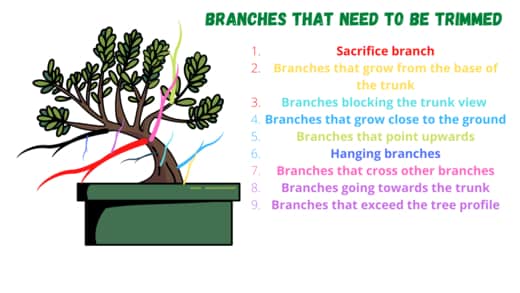
Avoid Heading Back Cuts
Ideally, you don’t want to head your Japanese maple by snipping unwanted branches in half. That’s just a recipe for disaster for any plant, but it’s even worse with the delicate bonsai.
These cuts at indiscriminate points ruin the plant structurally and aesthetically when it resprouts as a witch’s broom.
Instead, you want to thin the twig as close to its base as possible. You can do that by tracing it to where it stems, holding it between your fingers, and swiftly cutting the base off at an angle.
Ensure you don’t compromise the plant collar or the chunky base that joins the side branch to the main trunk.
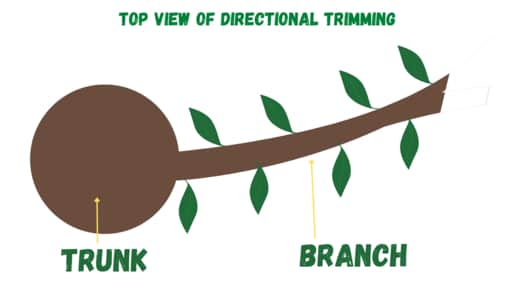
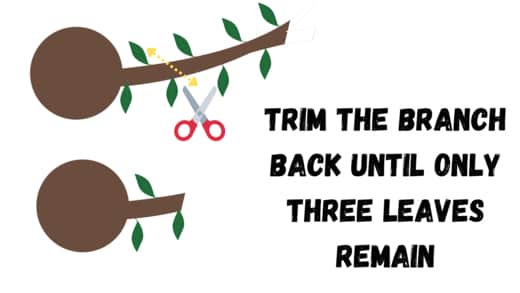
Snip Crowded Forks to Maintain the Bifurcation
Now that you have practiced the basic technique on the dispensable dead twigs and leave, you can make your way up to more advanced prunes.
Look around for multiple shoots coming out from a single point. You’ll need to tackle all these clumping shoots by snipping them at the fork base.
If you ever need to choose between three or more twigs from the same fork, always pick the two that are the thickest and most straightforward. The main goal here is to create a clear pattern of bifurcation that shapes the bonsai’s taper nicely.
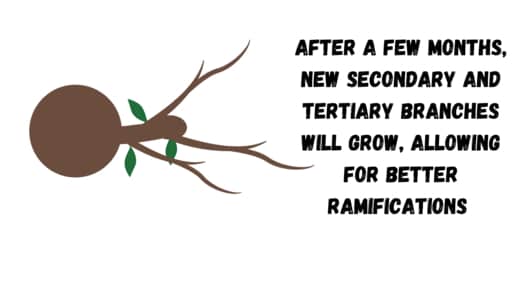
Open up the Bonsai Tree’s Center to Let the Light In
When you’re done with the clumped forks and dead leaves, you might want to take a step back and look at the big picture. This step should help you improve the bonsai’s aesthetic by opening the center.
You can do this by spotting all the branches that cross each other.
Or identifying those that point back to the center.
These strays can deprive the center foliage of proper light and space for growth. Plus, they make weak attachments.
So, from a distance, imagine the perfect overall shape for the Japanese maple bonsai and how the branches would ideally flow. Then, remove any branches that ruin this flow, but always with thinning cuts, not heading back!
3 Common Problems People Have When Pruning Bonsai
Although the main steps to pruning bonsai trees are more-or-less straightforward, a few problems are bound to pop up.
Here are the common mistakes to watch out for when pruning your Japanese maple bonsai:
Wrong Timing
While pruning can be very beneficial, doing it in the wrong time frame can do more harm than good.
The tricky part is that the right time changes based on the main goal you’re trying to achieve and the bonsai’s state.
For one, warm months from June to August work best when trying to tame the Japanese maple into shape. That’s mainly because the plant will be just done with its spring growth sprout.
Season | Should you trim |
Spring | Only in the late spring once the leaves have grown and hardened |
Summer | Yes |
Fall | Only once the leaves have dropped |
Winter | Yes |
Meanwhile, if you want to encourage growth, you might be better off doing it during the winter dormancy when the plant is already bare.
Trunk Tears
When you’re snipping heavier branches, you risk creating small tears in the main trunk. That’s because the weight of the collapsing branch leans on the collar and pulls it down as it falls to the ground.
While you won’t regularly come across particularly hefty branches on a Japanese bonsai, the trunk is already delicate enough and tears easily.
That might be the only time you’ll need to cut a branch in half by heading cuts, then snip the rest at the base. It sounds a little counterintuitive at first, but this way, you get rid of some extra weight and reduce the load on the collar.
Over Pruning
Many new bonsai owners fall into the temptation of overdoing the pruning session.
For instance, it’s usually not a good idea to snip still-growing twigs with less than six leaves.
You still haven’t seen how they’ll grow out, so wait it out.
Remember that bonsai trees are hardly ever going to look perfect all the time. So, it’s okay to let it grow a little out of control between summer prunes.
How to Cut a Japanese Maple Bonsai When Pruning?
With all the common mistakes in mind, you might be looking for some pro tips to help you navigate your way along your first Japanese maple pruning session.
Your focus while cutting the bonsai should be thinning. This means that you’re only removing the strays to keep the tree lighter and more open.
A few tips to keep in mind are:
- Never snip the collar itself because it exposes the stem system to infections.
- Use sharp shears to swiftly get clean and precise cuts across before the branch snags or tugs on the trunk.
- Always cut with a purpose to avoid over pruning.
Why Is It Important to Prune a Maple Bonsai Tree?
Since pruning can be a risky chore, you might wonder why you need to do it in the first place. Well, some people prune bonsai trees as regular maintenance while others do it to fix structural flaws.
Either way, let’s take a look at three of the best reasons to prune the Japanese maple bonsai tree:
Adding a Growth Boost
As is the case with any other tree, pruning a Japanese maple can encourage growth. This happens because it stimulates cell turnover and redirects the resources for nearly-dead parts.
It also allows more flooding light to get to the canopy to help lateral shoots grow. So, it works, directly and indirectly, to help your bonsai grow faster.
Taming and Controlling the Overall Shape
When you open up the bonsai during pruning, you let the foliage grow better in the center and the bottom, which results in a more prolific look.
You’re also getting rid of all the stray twigs and clumped-up spots that could make the Japanese maple look off-kilter. So, overall, the tree also benefits aesthetically from pruning.
Reducing Post-Transplant Wilting
Sometimes, a lot of roots can get lost during transplantation. This loss usually translates to wilting since the plant can no longer balance the water demand with the supply, especially during the warm months.
Some people might need to compensate for the root loss by taking off more leaves than usual. This way, the plant survives until it regrows its roots to handle the higher water demand.
What Happens if You Don’t Prune a Japanese Maple Bonsai Tree?
So, pruning can come with many benefits for the bonsai, but what if you decide to skip it altogether?
Here are two possible risks to consider:
Pests and Mold Take Over
A bonsai with many damaged branches and leaves is a ticking time bomb. These decaying parts could attract pests that spread to other healthy branches or nearby plants.
Plus, an un-pruned potted Japanese maple is at a higher risk of root rot. This happens when the plant becomes so root bound in an attempt to increase water supply for all the excess leaves. Soon, the extra moisture around the clamped-up root system might lead to molding.
In that case, you might need to prune the bonsai’s infected roots and re-pot it.
You Lose Light Penetration
When too many crossing branches block the light to the center, you might start spotting more dead branches and leaves.
This ruins the look and puts you in a loop of decaying leaves and pests.
Should You Prune a Japanese Maple Bonsai?
In most cases, the benefits of pruning a Japanese maple outweigh the risks. So, let’s take a look at the advantages and disadvantages to expect here:
Advantages of Pruning a Japanese Maple Bonsai
- Helps the tree overcome stunted growth phases
- Trains the bonsai to grow in the desired directions while keeping it tame and center-heavy
- Reduces spreading pests
- Can be a very relaxing art form
Disadvantages of Pruning a Japanese Maple Bonsai
- Can harm the bonsai with trunk tears if done wrong
- Contaminated shears can transfer microbial infections into the collar
- Leaves bonsai fragile in front of strong winds
Do Maple Trees Make Good Bonsai?
The maple trees check all the right boxes when it comes to growing bonsai trees.
For one, your typical Acer palmatum has dazzling foliage that can give that dense and tapered dome look you need in your bonsai. In addition, the lobed leaves add a unique signature that makes the bonsai stand out from the crowd.
Plus, it can maintain a compact size in pots, provided that you prune it regularly, which is the hallmark of bonsai trees.
You can even let it grow as a part of your outdoor bonsai collection as long as you live around zones 5-8. Of course, if you’re not sure what zone your city belongs to, you can always use the USDA’s hardiness map to check the average estimates.
However, you need to put in the work year after year to get the maple to look like a proper bonsai tree.
Prune a Japanese Maple bonsai tree
Instead of relying on my experience growing Japanese maple bonsai, I wanted to get in touch with a few experts to get their feedback.
First, I visited my local botanical gardens and asked one of the employees there how often they would prune a bonsai tree like a Japanese maple – here is what they said:
“I’d recommend trimming a bonsai tree either in the spring or summer, only do it when the branches exceed the look you are going for. Do not overdo it.”
I also surveyed 20 plant paladin readers, asking them how often they make structural changes to their bonsai trees – here are the results:
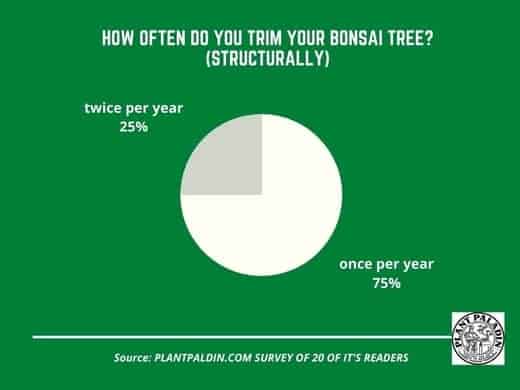
Final Thoughts
All in all, figuring out how to prune a Japanese maple bonsai tree is all about mastering the thinning technique.
Remember to identify your goal before you start—it’ll help you decide the ideal pruning window between winter dormancy and the warm summer months.
If done right, a simple prune session can keep your Japanese maple bonsai tame, fresh, and pest free. So, plan ahead, and get those sharp shears ready!
My top picks for the gear you will need!
So like I mentioned earlier, over the past three years of running PlantPaladin, hundreds of people have asked me for my recommendations on the best bonsai gear on the market.
Having spent thousands of dollars on bonsai items these past few years and tested at least 100 bonsai-specific products, I’ve listed my favorite products below – All of which I highly recommend and think you can get great value.
They can purchase directly by clicking the link to take them to Amazon.
Bonsai Tool Set: One of the significant challenges I’ve had is finding a toolset that was not only durable but didn’t break the bank. SOLIGT has recently developed a fantastic bonsai tool set that covers all the tools you need to trim, prune, and repot your trees. – You can grab it here.
Complete Bonsai Set: Many of you will want to grow your bonsai trees entirely from scratch, but finding the varicose seeds, pots, and other items in one place can be challenging. Leaves and Sole then have created a complete bonsai set that I’ve personally used that ticks all the boxes. You can grab it here.
Bonsai wire: The number of times I’ve run out of wire for my bonsai or purchased cheap bonsai wire that doesn’t do the job is embarrassing for me to admit. After a lot of trial and error, I found that using Hotop’s aluminum bonsai wire is one of the best options on the market. This can easily be used for both indoor and outdoor bonsai. You can grab it here.
This post was written by Fehed Nicass who has been passionate about bonsai for over 3 years. He currently resides in the UK and works in sales.
